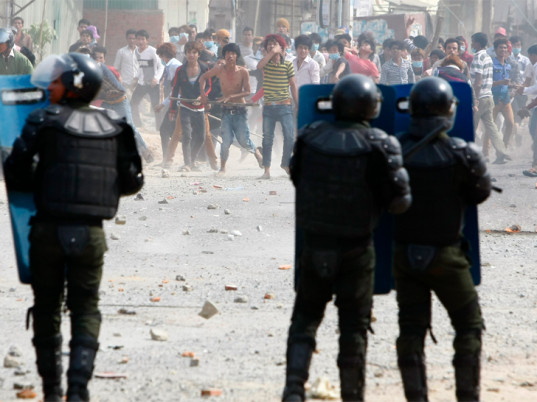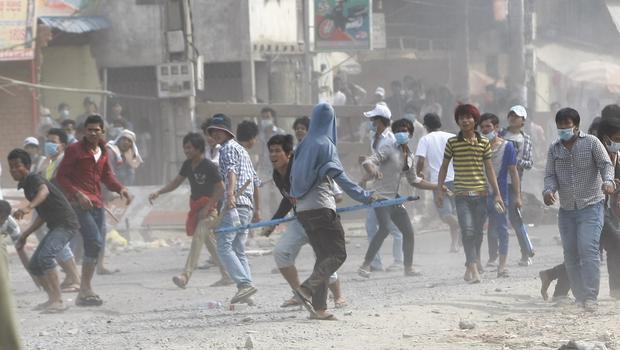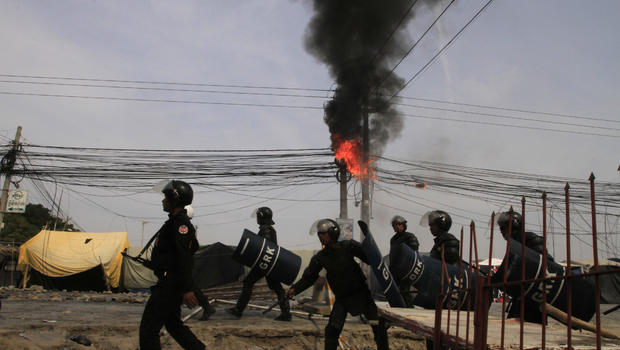Violence Erupts in Cambodia as Labor Dispute Intensifies
Workers at most of Cambodia’s more than 500 garment factories are on strike, demanding an increase in the minimum wage to $160 a month, double the current rate. The government has offered $100 a month.
The local human rights group LICADHO said in a statement that at least four civilians were shot dead and 21 injured in what it described as “the worst state violence against civilians to hitCambodia in 15 years.”The statement said that security forces used live ammunition to shoot directly at civilians.
|
“The use of live ammunition was prolonged and no efforts appear to have been made to prevent death and serious injury,” it said. “Reports suggest that security forces were also injured after being hit with stones.”
It was not clear whether those killed were workers or local residents who had joined in the protest. “They are anarchists, they have destroyed private and state property,” Chuon Narin, the deputy police chief, said by phone. “That is why our forces need to chase them out.” The protesters were cleared from the street, at least temporarily, by early afternoon. The violence comes at a time of political stress in the country, with the opposition Cambodia National Rescue Party holding daily protests calling for Prime Minister Hun Sen to step down and call elections. |
Although the wage and election issues are not directly linked, the opposition has close ties with the country’s labor movement. Last Sunday, many workers joined a massive political rally organized by the opposition.
The workers represent a potent political force, because the garment industry is Cambodia’s biggest export earner, employing about 500,000 people. In 2012, Cambodia shipped more than $4 billion worth of products to the United States and Europe.
Mak Vin, a 25-year-old worker, said he was among those protesting for more than a week over the wage issue. He said that on Friday morning, as the workers burned car tires and shouted slogans, “hundreds” of armed police arrived and opened fire.
“They fired live bullets directly at us. I am very scared,” Mak Vin said.
There had been an earlier clash overnight, with no known fatalities.
Mak Vin said the workers were protesting only for higher wages, and would return to work once that demand was met. He said most workers were not cowed by the shooting, and would continue their strike.
Violent suppression of social and political protests has not been unusual under Hun Sen’s authoritarian government, but there have been few incidents in recent years where more than one person has been killed.
The authorities also usually shy away from using live ammunition in Phnom Penh, where the population is largely hostile to the government.
But the U.N. special rapporteur on human rights in Cambodia, Surya Subedi, said it was the third time since the disputed elections that authorities have shot into a crowd and caused fatalities. He called for an independent investigation into whether excessive force was used. He also expressed concerned about increasing violence by some demonstrators.
The standoff over wages presents Hun Sen with a dilemma, as increasing violence could drive the workers into a tighter alliance with the opposition, providing a vast pool of people for their increasingly confident street demonstrations. But the government is also close to the factory owners, whose exports fuel the economy and who are generally seen as financial supporters of Hun Sen’s ruling Cambodian People’s Party.
Last week, violence erupts in Cambodia when the Garment Manufacturers Association in called for factory owners to close their plants, ostensibly for fear of damage by protesters. The situation puts pressure both on the striking workers, who are not being paid, and the government, which relies on garment exports to power the economy.






Leave a Reply
Want to join the discussion?Feel free to contribute!